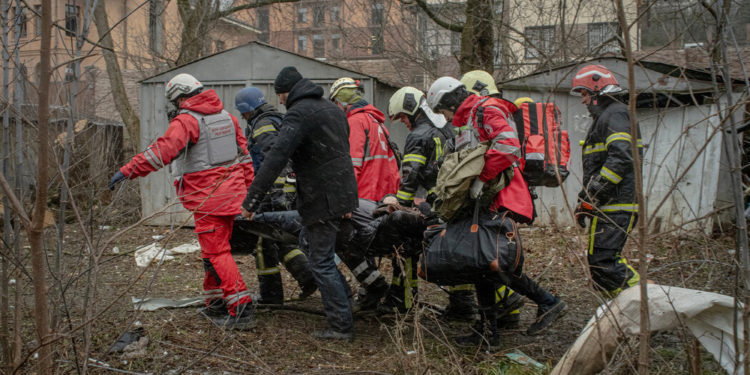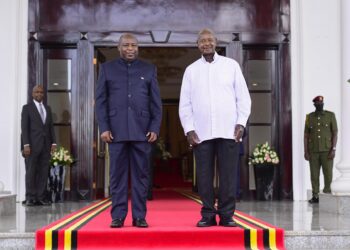By THE NEW YORK TIMES
Russian missiles and drones hammered Kyiv on Tuesday morning, officials said, in a large-scale attack on the Ukrainian capital and other cities that killed at least five people and injured nearly 130 others, a day after President Vladimir V. Putin of Russia promised to retaliate for a Ukrainian assault on a Russian city.
The barrage — which the Ukrainian Air Force said involved about 100 missiles, including hypersonic weapons that fly at several times the speed of sound — was the latest in an escalating cycle of air assaults between the two countries, as both sides look for ways to inflict damage away from the largely deadlocked front line.
Moscow claimed that Ukraine retaliated hours later on Tuesday, firing at least eight missiles on the Russian city of Belgorod. The attack killed one civilian and injured four others, according to the local governor. Later in the day, a strike hit the nearby town of Shebekino, the governor said, damaging an administrative building but causing no injuries.
The recent strikes against Ukraine may also be the start of another Russian air campaign against critical infrastructure. The Ukrainian authorities had warned for months that Russia was stockpiling high-precision missiles to pound cities once the weather turned cold in a repeat of last year’s bombing campaign. Experts believe that strategy is aimed at diminishing Ukrainian morale and weakening its military and industrial capacities.
Both sides have improved their air defenses in the past year, but they have also expanded their military capacity to hit targets away from the front lines. And as the past week’s cycle of strikes and counter-strikes escalates, Moscow and Kyiv are showing growing readiness to deploy these capabilities.
“This is a competition of endurance,” said Serhii Kuzan, chairman of the research group Ukrainian Security and Cooperation Center. He said that Ukraine’s powerful air defenses were now forcing Russia to launch massive air assaults with multiple weapons systems to be able evade interceptor missiles and hit some targets.
Gen. Valery Zaluzhny, Ukraine’s top commander, said the Ukrainian Army had shot down about three-quarters of the Russian missiles fired on Tuesday, including all 10 hypersonic missiles, with the help of Western-delivered Patriot missile batteries.
Mr. Kuzan said that Ukraine was also now more willing, and capable, of responding.
With each new attack, he added, Russia increasingly legitimizes “Ukraine’s retaliatory strikes against Russian air and naval bases, ammunition depots, defense enterprises and enemy oil bases.”
Both sides appear to be justifying the airstrikes as retaliation for previous attacks, in an escalating tit-for-tat that risks causing more civilian casualties, either from direct targeting or falling debris. Since the start of the war Russia has regularly targeted civilian areas in Ukraine, resulting in thousands of casualties.
In Kyiv on Tuesday, most of the casualties were reported at a nine-floor residential building that was partly destroyed and caught fire. Vitali Klitschko, the mayor, said that at least two people died and 49 others were injured there.
Residents of the building could be seen streaming out of the neighborhood on Tuesday morning, bags in hand, stepping onto piles of rubble, between smashed cars and into large puddles caused by damage to water pumps, as firefighters with smoke-blackened faces sprayed water on the blaze.
A man tried to rush past a line of police officers, yelling that his wife was still inside, possibly lying under the rubble. On a nearby street, two people ran after an ambulance, screaming that a woman needed urgent care. After the ambulance stopped, they helped her get inside.
“Oh my God, oh my God,” the woman said as she stepped into the ambulance.
The recent wave of missile attacks intensified on Friday, when a ferocious Russian missile barrage killed at least 39 people, wounded about 160 others and hit industrial and military infrastructure as well as hospitals and schools, Ukrainian officials said.
The next day — in what a Ukrainian official said was a response to Russia’s attack on Friday — a barrage of missiles killed 24 people in the Russian city of Belgorod — the deadliest attack on the Russian territory since the start of the war.
In New Year’s Day remarks, Mr. Putin vowed retaliation. “From our side, we will build up the strikes,” he said.
Hitting Kyiv on Tuesday appeared to be a prime objective. Air-raid alerts sounded throughout the morning, as wave after wave of missiles rained down, punctuated by loud bangs of air defense systems trying to destroy them. Massive plumes of black and white smoke rose over the capital, cutting through the gray early morning sky, as several buildings were hit.
On Tuesday, the Belgorod region came under attack again, according to Russian officials, in what may have been Ukraine’s response to the morning’s strikes. Ukrainian officials have not yet commented on that assault.
Ukraine’s largest Western allies have explicitly prohibited the government in Kyiv from using the weapons they supply to hit targets inside Russia’s internationally recognized borders. Russia’s defense ministry claimed that Ukraine’s latest attacks on the Belgorod region on Tuesday were launched from Ukrainian-made Vil’kha multiple rocket launcher, highlighting the country’s growing domestic military capabilities.
For its part, analysts believe Russia has been able to expand its own missile production in the past year despite Western sanctions. Ukrainian officials warned in the fall that Russia had stockpiled more than 800 high-precision weapons in preparation for massive winter assaults.
.
It was not immediately clear what, exactly, the Russian military tried to hit in its attacks against Kyiv on Tuesday. At least two facilities located in an industrial zone in the north of the capital were hit, and remained shrouded in billows of smoke by midday. Ukraine’s Energy Ministry also said that nearly 260,000 residents had been temporarily left without electricity on Tuesday, suggesting that the power grid may have been one of the targets.
“Those missiles are a bit random,” said Serhii Zarybin, an employee of a cement factory, as he looked at what was left of a large auto repair workshop burned down in a strike. In front of him, dozens of cars were charred and twisted metal sheets were scattered all around, while a thick cloud of white smoke hovered above the site.
At the residential building that was hit on Tuesday, the same scene was visible again and again on each of the nine stories: doors smashed by the blast and debris of furniture everywhere on the floor. Police officers were entering the apartments trying to determine whether some residents had been trapped under the rubble.
On one floor, pillows and blankets were laid in a corridor, covered with debris. Ukrainians often take shelter in the corridor of their homes during air assaults, using the walls to protect themselves from blasts.
Coming down the stairs, which were scattered with brick dust and shards of glass, Lidiia Dudchenko, 71, said, “There was an explosion, and it was a miracle we survived.”
“I have never experienced anything so terrible,” she added.
In another apartment, Yevhen Pesiura, 40, was packing clothes and precious belongings in a suitcase, shards of glass cracking under his feet. “I can’t live there anymore,” he said, with cuts on his face, pointing at the scene of devastation in his apartment.
Resentment toward Russia ran high in Kyiv after Tuesday’s attack and, as the war drags on, it may fuel the country’s determination to bring the fighting to Moscow’s doorstep.
Looking at a factory that was engulfed in a massive plume of gray and yellow smoke, Serhii Dubov, 45, said he just wanted “the other side to feel the same thing that we’re feeling.”
“I just want that they also end up sitting in their basement while listening to explosions,” he said, “and be scared.”
Daria Mitiuk and Oleg Matsnev contributed reporting.







Discussion about this post